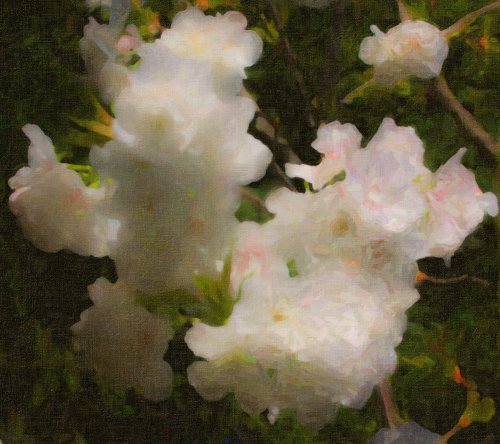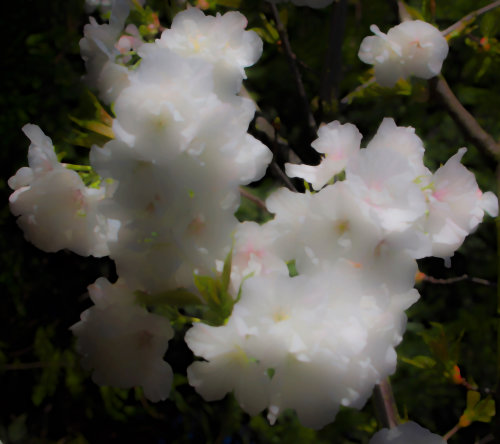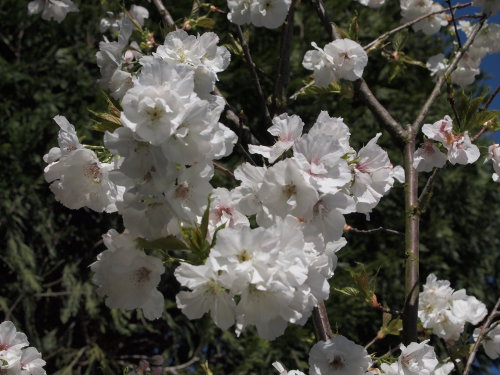Photo Corners headlinesarchivemikepasini.com
![]()
A S C R A P B O O K O F S O L U T I O N S F O R T H E P H O T O G R A P H E R
![]()
Enhancing the enjoyment of taking pictures with news that matters, features that entertain and images that delight. Published frequently.
Monetization



15 April 2019
Currently on exhibit at the de Young Museum in Golden Gate Park, Monet: The Late Years features nearly 50 paintings by Claude Monet dating mainly from 1913 to 1926. We wandered through the galleries yesterday, dodging the smartphones and taking it all in.

Snap Art. The more painterly version, adding canvas, oil impasto, color variation.
We brought along our Micro Four Thirds outfit and our own smartphone but we didn't take a single photo. We didn't want to shoot the whole show (you can) and we didn't favor one over another painting.
Besides, we simply wanted to enjoy the experience for once rather than get increasingly annoyed with the crowd passing innocently in front of our composition. A quieter day, if we happen to stumble on one, would be better, we thought.
So we spent our time reading the introductory material at the entrance to each room and looking at the paintings.
℘
THE FIRST THING we appreciated is that Monet was losing his sight to the cataracts that were first diagnosed in 1912. Before undergoing cataract surgery in 1923, he was blind in one eye and had only 10 percent vision in the other. After surgery, he had to wear corrective lenses.

Photoshop. An early Monetization of the camera shot seen below.
He had already memorized the location of the pigments on his palette, we're told, so he could continue painting as his eyesight failed. But his brush strokes became broader and his canvases huge.
That makes it difficult to divine any detail in the paintings. But if you look a while at them, you will begin to see the sky, trees and clouds reflected in the paintings of the lily ponds at Giverny.
"These landscapes of water and reflections have become an obsession," he admitted in 1908.
℘
AND OBSESSION is not too strong a word.
He diverted the Epte River to create a pond for cultivating his water lilies. And he hired eight gardeners to maintain it, skimming leaves from the surface of the water every day and dunking the water lilies to clean them of dust stirred up by traffic on the nearby road. A road which he had paved to reduce the dust.
It's hard to imagine the dusty water lilies inconveniencing a man who couldn't see.
℘
HIS PAINTINGS became more and more obscure. There are some of the Japanese footbridge in his garden in which you need to be told there is a bridge in the image before you notice it.
These aren't the images you see in the gift shop, of course.
But they tell the story of a man who would not put down his brush despite his disability. A disqualifying disability. How can a painter who can't see paint?
Well, go back to the dusty water lilies.
It's about expression. And expression blossoms from feeling. No feeling, no emotion, no expression. He knew the water lilies were dusty and it bothered him. When he knew they had been washed clean, he was free to revel in them and express his irrepressible spirit of creativity. He, like them, floated above the cold depths of life.
℘
SOMETIMES IT PAYS to keep you finger off the shutter button.
When we left the exhibit without any images, we wondered what the photographic equivalent might be. What would a "Monetization" of an image look like?
With horror we realized it would have to contradict all the values we usually work so hard to achieve in a photograph. The tonality would look underexposed. The color too saturated. There would be no detail in the image. Much of it would be blurry.
Could that possibly work?
We didn't know but we thought it was worth a try, if for no other reason than to unwrap ourselves from the pole of our presets.
℘
IT WASN'T EASY. Nor particularly successful.
We started with a recent image of some cherry blossoms crossing from shade into sun, which we brought into Camera Raw.

Camera JPEG. Not a good photo but a nice scene.
In Camera Raw, we slid all the sliders we usually tweak one way toward the opposite direction. Sometimes all the way. That was a good start.
We knew we could use the Camera Raw filter on the image, which would let us do all that even more, but we went with filters to affect color and blur.
That was, we thought, as far as an image editor bound by photographic parameters would take us. But we weren't where we wanted to go yet.
℘
SO WE OPENED THE IMAGE in Alien Skin's Snap Art 4.
Alien Skin is famous for special effects in all of its software. It's image editing software Exposure X provides many unique photographic effects including borders, scratches and light leaks.
But we were looking for painterly effects. So Snap Art, which transforms photos into traditional art pieces was just the ticket.
We had already obscured the detail. Now we wanted to bring out the color and restore detail only by exposing the supporting canvas.

Snap Art. Canvas texture and enhanced color.
We went through the panels, exploring our options and gradually transforming the image toward what we had imagined.
Suddenly we were there.
The rather unhappy photo of the cherry blossoms had become a painterly explosion of color, more articulately expressing the joy at seeing them burst into spring.
℘
WE HAVEN'T GIVEN UP on the idea of returning to the exhibit to take a few photographs of Monet's later work. But we're glad we approached it differently this time, trying to capture in one of our own images what we appreciated in the work of the master.
Still, we have the feeling that we haven't yet completely monetized the image. There's more we might do, more we might try, other ways into the beauty we appreciated on that sidewalk under the cherry blossoms a few days ago.
One never does quite finish something like that, we think. So the old man in his spectacles returned to his garden day after day to paint what he had already painted.
To continue a conversation with the world in which one never has the last word.